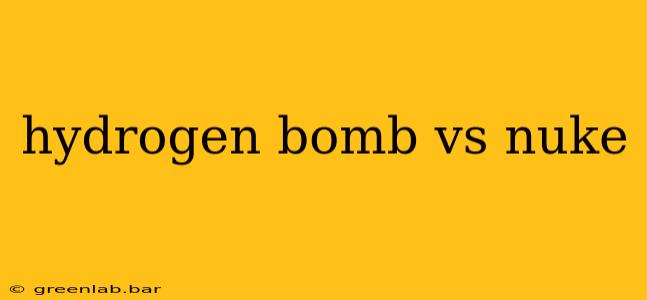The terms "hydrogen bomb" and "nuke" are often used interchangeably, leading to confusion. While both are nuclear weapons causing devastating destruction, there are crucial distinctions in their design, power, and effects. This article delves into the core differences between these weapons, explaining the science behind them and the implications of their use.
What is a Nuke?
The term "nuke," short for nuclear weapon, is a broad category encompassing both fission and fusion weapons. A fission weapon, more commonly known as an atomic bomb, utilizes nuclear fission—the splitting of heavy atomic nuclei (like uranium or plutonium) to release tremendous energy. This process creates a chain reaction, resulting in a powerful explosion. The bombs dropped on Hiroshima and Nagasaki were fission weapons.
What is a Hydrogen Bomb?
A hydrogen bomb, also known as a thermonuclear weapon, is far more powerful than a fission bomb. It leverages nuclear fusion, the process of combining light atomic nuclei (like isotopes of hydrogen, deuterium, and tritium) to form a heavier nucleus (helium), releasing even greater energy than fission. The fusion reaction requires extremely high temperatures and pressures, typically initiated by a fission bomb detonation. This "primary" fission stage triggers the fusion "secondary" stage, resulting in a significantly more powerful explosion.
Key Differences: Fission vs. Fusion
| Feature | Fission Weapon (Atomic Bomb) | Fusion Weapon (Hydrogen Bomb) |
|---|---|---|
| Mechanism | Nuclear fission (splitting of atoms) | Nuclear fusion (combining of atoms) |
| Fuel | Uranium-235 or Plutonium-239 | Deuterium and Tritium (isotopes of hydrogen), often with Lithium |
| Yield | Relatively lower explosive power (kilotons) | Significantly higher explosive power (megatons) |
| Complexity | Relatively simpler design | Significantly more complex design |
| Fallout | Moderate to high levels of radioactive fallout | Can produce extremely high levels of radioactive fallout, depending on design |
| Environmental Impact | Significant local and regional environmental impact | Widespread and potentially long-term global environmental impact |
The Power Differential: Kilotons vs. Megatons
The explosive power of nuclear weapons is measured in kilotons (thousands of tons) or megatons (millions of tons) of TNT equivalent. Fission bombs typically have yields in the kiloton range, while hydrogen bombs can reach yields in the megaton range—thousands of times more powerful. This immense difference in yield translates to drastically larger areas of destruction and longer-lasting consequences.
The Implications of Thermonuclear Weapons
The development of the hydrogen bomb marked a significant escalation in the global arms race. Its immense destructive power and potential for widespread environmental devastation raise serious concerns about its use and the long-term impact on humanity and the planet. The potential for global fallout and long-term radioactive contamination makes hydrogen bombs a particularly dangerous and ethically problematic class of weaponry.
Conclusion
While both fission and fusion weapons are devastating, hydrogen bombs represent a far greater threat due to their significantly increased explosive power and potential for catastrophic environmental consequences. Understanding the differences between these weapons is crucial for informed discussions about nuclear proliferation, disarmament, and the dangers of nuclear war. The continued existence of these weapons underscores the critical need for global cooperation and efforts toward peace.

